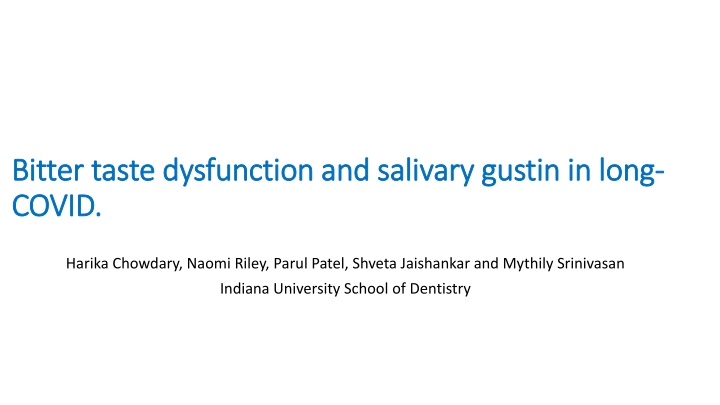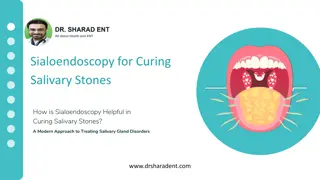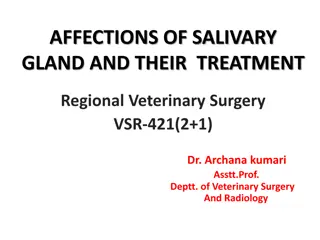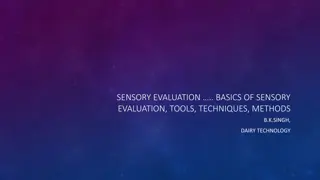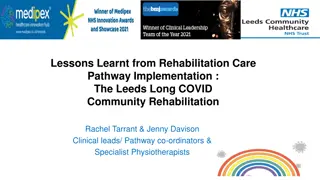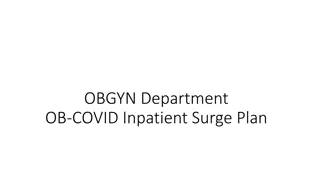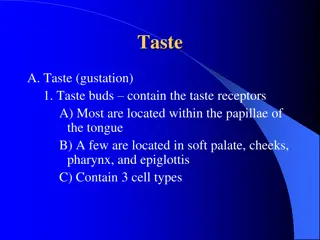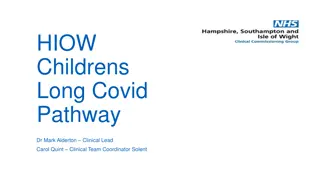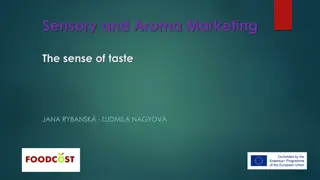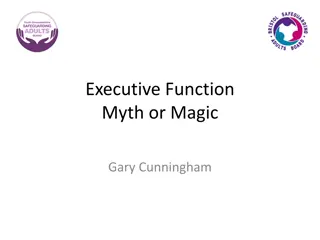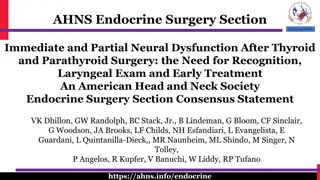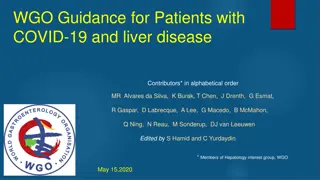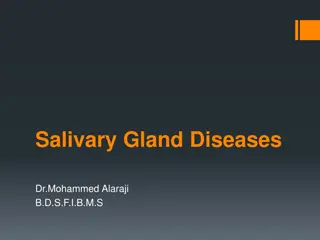Salivary Gustin and Taste Dysfunction in Long-COVID Patients
The research explores the association between taste perception and the duration of COVID infection in long-COVID and COVID-reinfection cases. Reduced salivary gustin levels correlated with lower taste scores in long-COVID patients. The study also found an increase in the bitter taste receptor gene expression and elevated inflammatory cytokines in the saliva of long-COVID individuals. Salivary gustin could serve as a potential marker for taste dysfunction in long-COVID, highlighting the importance of understanding taste-related proteins in saliva for patient care.
Download Presentation

Please find below an Image/Link to download the presentation.
The content on the website is provided AS IS for your information and personal use only. It may not be sold, licensed, or shared on other websites without obtaining consent from the author.If you encounter any issues during the download, it is possible that the publisher has removed the file from their server.
You are allowed to download the files provided on this website for personal or commercial use, subject to the condition that they are used lawfully. All files are the property of their respective owners.
The content on the website is provided AS IS for your information and personal use only. It may not be sold, licensed, or shared on other websites without obtaining consent from the author.
E N D
Presentation Transcript
Bitter taste dysfunction and salivary Bitter taste dysfunction and salivary gustin COVID. COVID. gustin in long in long- - Harika Chowdary, Naomi Riley, Parul Patel, Shveta Jaishankar and Mythily Srinivasan Indiana University School of Dentistry
Prevalence of long COVID symptoms among participants 16 years of age who reported having long COVID after a first or second severe acute respiratory syndrome coronavirus 2 infection.
Association between duration and taste perception in long-COVID and COVID-reinfection. Worse than pre-COVID <12 months 12-24 months >24 months Chi square p-value Long COVID (35) 17 (49%) 11(31%) 7(20%) Taste 6.23 0.043 COVID reinfection (18) 5 (28%) 12(67%) 1(6%) Long COVID (45) 24 (53%) 14(31%) 7(16%) Smell 17.56 0.0002 COVID reinfection (19) 6 (32%) 13(68%) 0 A higher percentage of individuals reported both taste and smell perception worse than pre-COVID in both the long-COVID and COVID-reinfection cohorts. 35% 35% 30% 30% 25% 25% 20% 20% 15% 15% 10% 10% 5% 5% 0% 0% Taste Only Both taste and smell Smell only Taste Only Both taste and Smell only smell Jaramillo M, Thyvalikakath TP, Eckert G, Srinivasan M. Characteristics of Chemosensory Perception in Long COVID and COVID Reinfection. J Clin Med. 2023 May 22;12(10):3598.
Taste related proteins and taste cells in saliva of long -COVID Once More than once 14 3500 3000 Gustin (pg/ml) 4000 SHH (pg/ml) 3000 2500 No 3000 Number 16 2500 2000 2000 2000 Average age (years +/- SD) Total taste score Impaired bitter taste Impaired sweet taste Impaired salt taste Impaired sour taste 51.8 +/- 15.8 33.8 26% 6.5% 6.5% 6.5% 51.5 +/-11.8 1500 1500 1000 1000 1000 28.7 16% 12.9% 3% 3% 0 500 500 0 0 0 5 10 0 5 10 Bitter taste score Bitter taste score 25 Pre-COVID Long-COVID 3500 Relative mRNA expression 20 3000 Pre COVID Long COVID 15 2500 3500 2000 pg/ml No COVID Long COVID 10 1500 3000 1000 5 2500 500 0 0 K10 TAS2R38 IL-6 IFN- sCD14 2000 1500 Conclusions: Reduced salivary gustin correlates with lower taste score in long COVID. Exfoliated taste cells are present in human saliva. Transcript for the bitter taste receptor gene, T2R38 is increased in long-COVID saliva. Inflammatory cytokines are elevated in long-COVID-saliva. Translational potential: Salivary gustin could be a marker for taste dysfunction in long-COVID. 1000 500 0 Total protein (mg/ml) SHH (pg/ml) CA-VI (pg/ml) Statherin (pg/ml)
